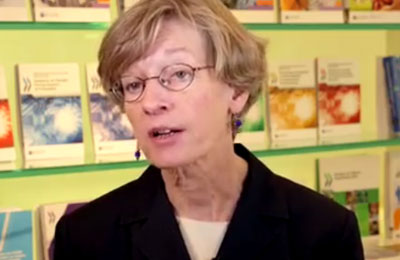
Catherine L Mann...Global economy facing risk of stagnation
Stronger policy urged to cut risks to economic growth
PARIS, November 26, 2014
Modest global economic forecasts, continuing high unemployment, and downshifts in potential output call on governments to fully employ monetary, fiscal and structural policy levers to support growth, a report said.
The Economic Outlook report draws attention to a global economy stuck in low gear, with growth in trade and investment under-performing historic averages and diverging demand patterns across countries and regions, both in advanced and emerging economies.
“We are far from being on the road to a healthy recovery. There is a growing risk of stagnation in the euro zone that could have impacts worldwide, while Japan has fallen into a technical recession,” OECD secretary-general Angel Gurría said.
“Furthermore, diverging monetary policies could lead to greater financial volatility for emerging economies, many of which have accumulated high levels of debt.”
Global GDP growth is projected to reach a 3.3 per cent rate in 2014 before accelerating to 3.7 per cent in 2015 and 3.9 per cent in 2016, according to the Outlook. This pace is modest compared with the pre-crisis period and somewhat below the long-term average.
The euro area is projected to grow by 0.8 per cent in 2014, before slight acceleration to a 1.1 per cent rate in 2015 and a 1.7 per cent rate in 2016.
A prolonged stagnation in the euro area could drag down global growth and have knock-on effects on other economies through trade and financial links. A scenario in the Outlook shows how a negative shock could lead an extended period of very low growth and very low euro inflation, resulting in unemployment remaining at its current unacceptably high level.
“With the euro zone outlook weak and vulnerable to further bad news, a stronger policy response is needed, particularly to boost demand,” said OECD chief economist Catherine L Mann. “That will mean more action by the European Central Bank and more supportive fiscal policy, so that there is space for deeper structural reforms to take hold. A Europe that is doing poorly is bad news for everyone.”
Among the major advanced economies activity is gaining strength in the United States, which is projected to grow by 2.2 per cent in 2014 and around 3 per cent in 2015 and 2016. In Japan, growth was impacted by consumption tax hikes in 2014, with expected growth of only 0.4 per cent in 2014, and rises modestly to 0.8 per cent in 2015 and 1 per cent in 2016.
Large emerging economies are projected to show diverging performance over the coming years. A slowdown in China, towards more sustainable growth rates, will see GDP growth drop from a 7.3 per cent growth rate in 2014 to a 7.1 per cent rate in 2015 and a 6.9 per cent rate in 2016.
However, the rapid increase in credit, rising share of non-bank credit as well as housing market and local government activity are raising concerns about financial stability.
A scenario in the Outlook shows that a 2-percentage point decline in the growth of Chinese domestic demand would lower global GDP by 0.3 percent per year. – TradeArabia News Service







